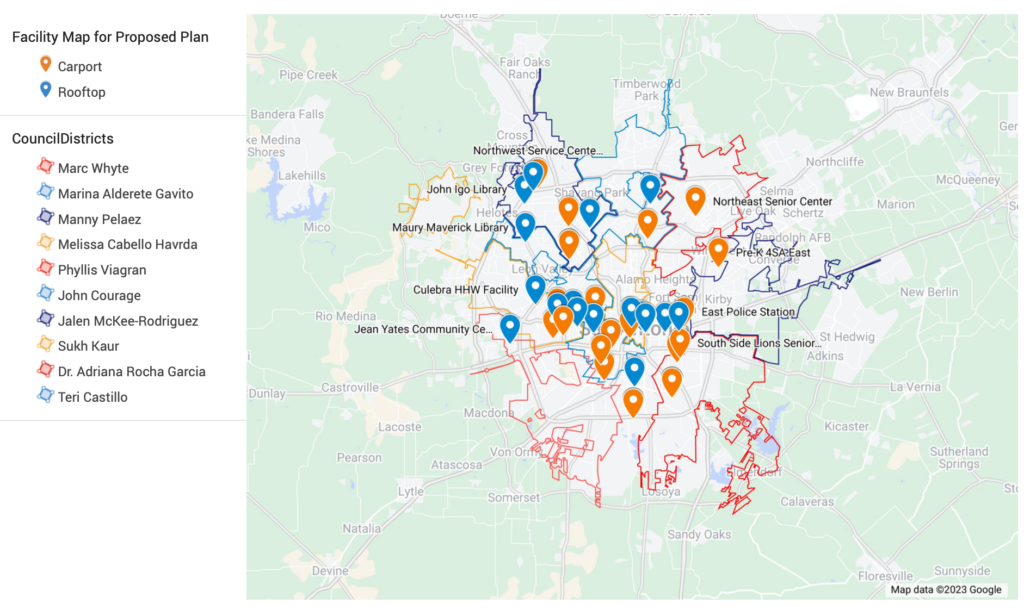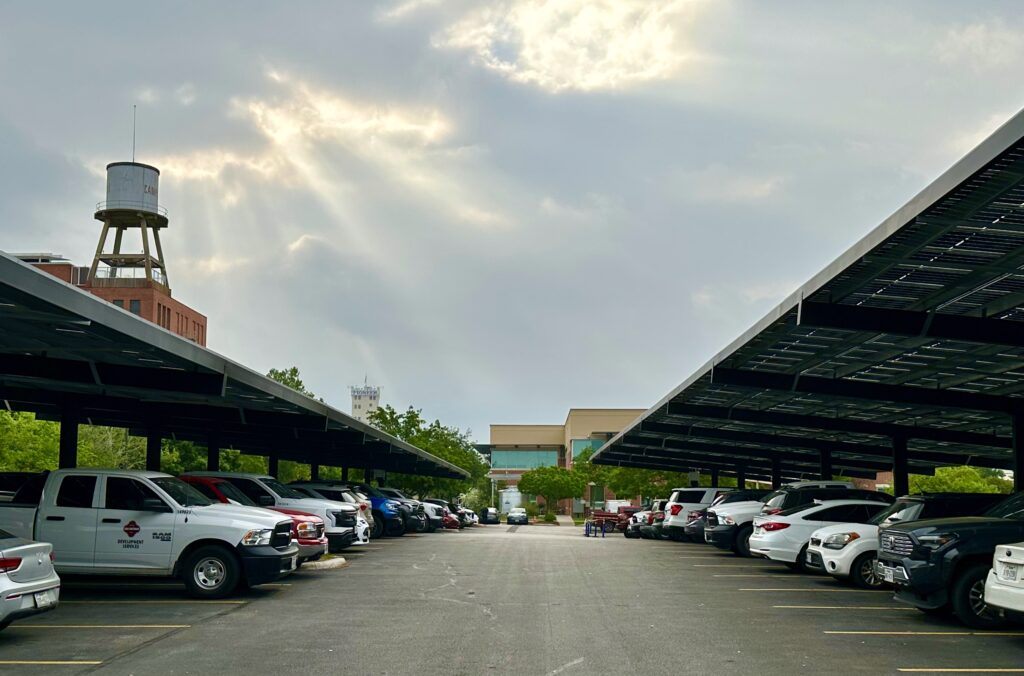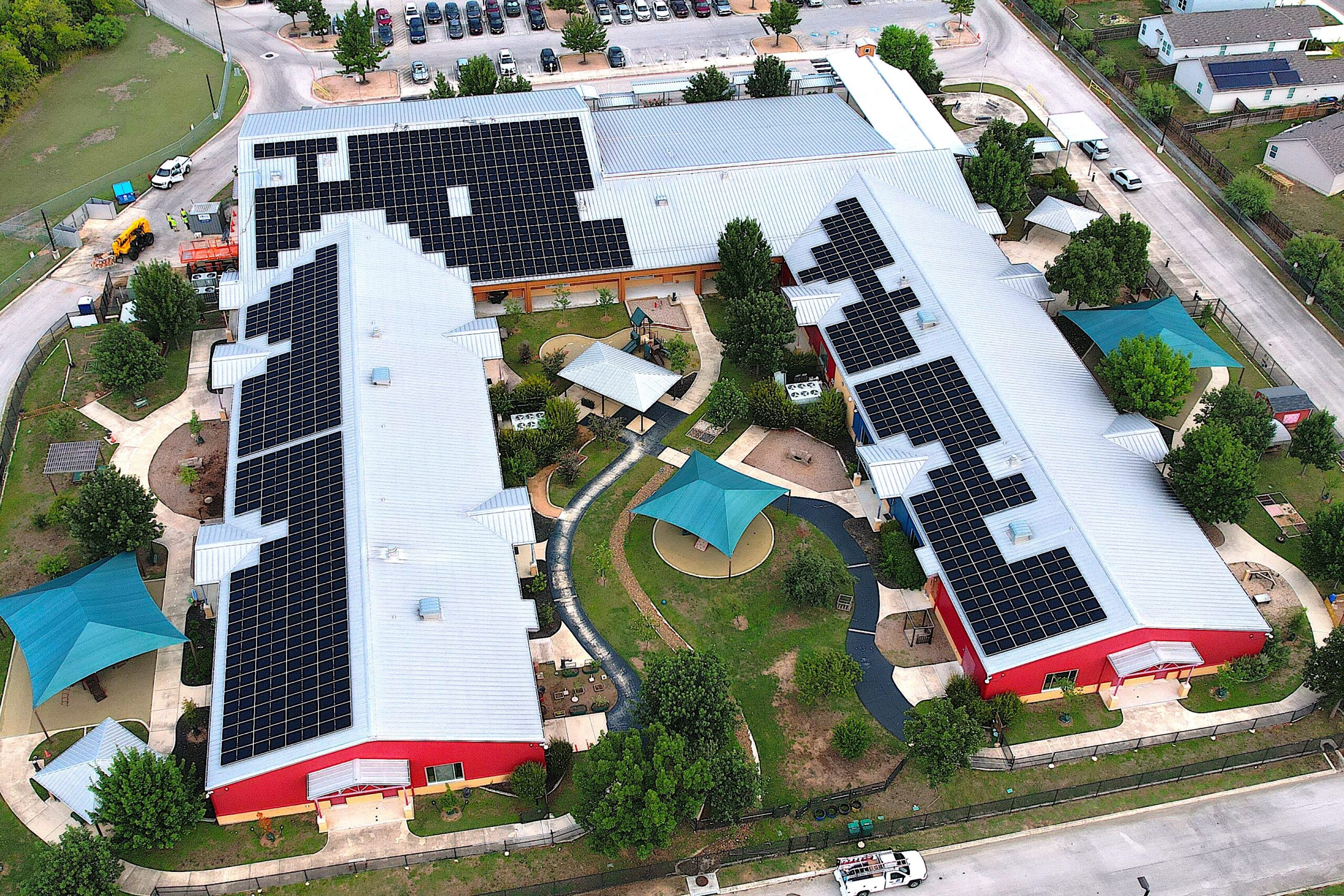Local Government:
San Antonio, TexasProject:
Multi-Site Municipal SolarCategory:
On-Site SolarProject Purpose

To deploy solar locally on at least 42 municipal facilities, parks, and parking lots to make progress toward San Antonio’s 2040 goal of zero net energy for all municipal buildings.
Project Overview
In October 2019, the City of San Antonio adopted its SA Climate Ready plan, with the goal of making San Antonio carbon neutral by 2050. To lead by example, the City of San Antonio finalized a deal in November 2023 to install an estimated 13.1 megawatts (MW) of solar across 42 city-owned facilities and parking lots. Site-by-site progress can be tracked here.
The City leveraged its own buildings and parking lots to invest in cost-effective clean energy throughout the city. The Office of Sustainability worked with 11 city departments to generate a list of 80 potentially viable sites to include in its procurement. This procurement team also included representatives from CPS Energy, the City’s electric utility, and technical advisors from RMI (founded as Rocky Mountain Institute). The City aimed to pursue a bulk purchase to achieve economies of scale and streamline the overall procurement process – far more time and cost-efficient than pursuing sites individually or department by department.
“Cities need to be leaders in addressing climate change. San Antonio is proud to strategically use its own facilities reduce the impact of our municipal operations and set an example for how other local governments can deploy clean energy and reduce emissions. This innovative solar project also puts state and federal incentives to work for San Antonio and displays the diverse benefits of onsite solar, such as green jobs, urban heat island mitigation, and community resilience.”
Doug Melnick, City of San Antonio Chief Sustainability Officer
The City signed master services agreement with local solar developer Big Sun Solar. The contract includes the option for additional services should the city wish to add other viable sites beyond the 42 identified. While the City will own the solar arrays across all its facilities, it also signed a separate contract from the developer to pay for annual operations and maintenance and ensure the project is performing efficiently and effectively. To ease the upfront cost impact, the City is also strategically borrowing $2.5 million in a low-interest loan program from Texas’ State Energy Conservation Office.
Over the 25 years, the $30 million upfront investment is conservatively expected to result in a net savings of $7-11 million and hedge against higher utility rates in the future.

This deal is notable for two key reasons. First, it is the largest on-site solar project by a local government in Texas and is one of the largest multi-site, on-site solar deals in the country (second only to New York City’s multi-site procurement across 88 sites). In addition, San Antonio’s project will be one of the first major US local government solar deals to take advantage of new Inflation Reduction Act’s clean energy incentives, including the Direct Pay mechanism. Direct Pay will allow the City to own the system and capture key tax credits (even as a tax-exempt entity) to reduce the upfront capital costs.
San Antonio’s innovative multi-site deal will result in multiple benefits, including energy and cost savings, shade and weather protection, and local jobs.
- Energy and Cost Savings: The projected 18,401,842 kWh generated annually from the 42 sites once built will offset an estimated 13% of the City’s electricity consumption from its buildings, according to 2022 data. This is expected to result in cumulative net financial savings between $7-11 million over 25 years.
- Shade and Weather Protection: The 23 parking canopies will not only power on-site municipal operations but also will provide shade and hail protection to people and vehicles. These canopies will be increasingly valuable, as San Antonio set a new record in 2023 of 75 days at or above 100°F (the prior record of 59 days was set in 2009).
- Local Jobs: The selected developer, Big Sun Solar, estimates this will create 15-17 full time jobs and include a solar installation partnership with a smaller residential solar installer to increase their firm’s ability to build small-scale commercial solar developments and de-risk their work. Big Sun Solar also collaborates with the St. Phillips College Solar Apprenticeship Program (part of the Alamo Area District of Community Colleges) to train students in solar energy, offering a pipeline for employers.

Why did you choose this procurement approach?
San Antonio is the 7th largest city in the United States by population and is in a unique regional position to be able to contribute to the local solar market and leverage its long list of assets. In addition, the City owns a municipal utility, CPS Energy, which is focused on community-wide energy management. By pursuing on-site solar, the City aimed to reduce its energy bills on the assets it directly manages and hedge against future fuel cost increases.
However, the City wanted to meaningfully advance its climate goals and save energy. On-site solar on a site-by-site basis can be inefficient to scale given the competitive process and smaller pace of progress. Instead, the Office of Sustainability created a process to pursue a bulk purchase of on-site solar for individual sites. The City followed the below approach for identifying and shortlisting sites:
- First, the Office of Sustainability requested input from 11 City departments on potential sites, including community centers, libraries, service centers, public safety facilities, and parking lots. Sites were particularly of interest if they had a minimum facility footprint of 15,000 square feet and had no other site constraints (e.g., poor roof conditions or future renovations planned).
- The Office of Sustainability and its advisors narrowed down the list of over 100 municipal facilities and parking lots based on technical feasibility, evaluating prospective sites for shading, current electricity consumption, estimated solar generation, and potential construction conflicts (e.g. renovation plans). The City used the Municipal Solar Site Selection Tool to help vet and organize its sites, Google’s Project Sunroof to assess shading, and NREL’s PVWatts tool to estimate solar system sizes and expected electricity generation.
- Then, the City compared the potential electricity generation with current building electricity consumption data to estimate the appropriate system size for each facility.
This upfront analysis helped the City understand whether the technical potential estimated was worthwhile to pursue – and whether certain sites would be attractive to solar developers. Ultimately, the 80 city-owned sites offered in the RFP were vetted for technical and market feasibility.
“Collaboration across departments is essential for implementing our climate plan. So our Office of Sustainability brought together departments from the beginning, which was necessary to get the project to the size and scale that it now is.”
Golda Obinzu, City of San Antonio Energy Manager
What were San Antonio’s biggest challenges in setting up this project?
A New Energy Policy Landscape: The changing national policy landscape further complicated the review process but also offered new opportunities. As the City was finalizing its RFP in August 2022, the U.S. Congress passed the Inflation Reduction Act. This created new incentives, enhanced existing tax credits, and established the new mechanism of Direct Pay (also called Elective Pay). While additional incentives were helpful, Direct Pay made it possible for the City as a tax-exempt entity to own the solar projects and claim a majority of the tax credits previously reserved for solar developers, private financing partners, and investor-owned utilities.
Before the Inflation Reduction Act, local governments and other tax-exempt organizations would generally have to sign a power purchase agreement (PPA) or lease with a tax-liable third party to receive the benefits of any tax incentives for a new project. Direct Pay is particularly useful for tax-exempt entities, like the City of San Antonio, that want to own a project that would not be as affordable without the tax credits and are in a regulated electricity market or utility territory that restricts electricity purchases from a third party. And because all of the City’s rooftop or parking canopy solar arrays are under 1 MW in capacity, the City is not subject to the domestic content requirements for Direct Pay.
Determining City Ownership vs. Third-Party Contract Options: As San Antonio was developing its site list, it was also weighing whether to solely pursue ownership options or entertain creative public-private partnerships. This was further complicated by the lack of clarity surrounding the newly created Direct Pay mechanism. Ultimately, the City wanted to keep its options open. Accordingly, the RFP included the following language:
“The City recognizes that product offerings in the power market are evolving…. Each respondent should provide a base proposal assuming City-owned solar systems installed on City-owned facilities. Respondents may also offer alternative, creative solutions to help achieve cost savings and/or cost neutrality and the City’s other objectives, but those solutions will need to be vetted against City and CPS Energy policies and processes.”
City of San Antonio Request for Proposals
Complementing the RFP was a bid sheet template created by the City’s team that asked solar developers to offer preferred and alternate proposals, at least one of which at least had to assume City ownership. The City separately created a calculator to consistently compare the net present value of the projected savings. This calculator was developed to be agnostic of ownership structure.
Is there anything you wished you knew at the beginning of the project or that you would do differently based on your experience with this project?
What the Full Evaluation Process Would Involve: Because the City owns a municipal utility, energy procurement was not previously managed by the City’s Finance Department. Understandably, there was a steep learning curve for solar procurement – let alone this multi-site approach. From the beginning of the site selection process, the Office of Sustainability invited the City’s procurement staff to support and ask questions. The multi-site approach was an effort to streamline what could be multiple procurements into one – and achieve economies of scale through a bulk purchase. More challenging was how this would be evaluated consistently across different ownership models and different proposed plans.
The Office of Sustainability, Finance Department, and the City’s technical advisors worked together to co-create a bid sheet template for respondents and a calculator for the City’s Evaluation Committee to use bid sheet information and score proposals on consistent metrics. While the Inflation Reduction Act offered new incentives for the City to consider, it also complicated the City’s evaluation process. The City had to balance consistency in evaluation while also allowing for potential differences in the proposed plans offered by developers. This took time and focused discussions to understand and address concerns from the Finance Department, but the collaborative and iterative approach ultimately achieved buy-in from all parties involved.
“Although it was a long development timeframe, our process yielded consensus on moving forward with a two-phased approach of shortlisting based on qualifications and then seeking pricing. It worked well, and I would advise other cities to replicate this process and plan accordingly for a longer process than a standard RFP. It helps to qualify those firms that can really do the job and then allows for a more tailored approach to their plan and associated price and value add.”
Denise Gomez-Esquivel, City of San Antonio Procurement Administrator

The City’s multi-phase evaluation process also helped increase buy-in among core decision-makers and the Evaluation Committee. The City first requested qualifications and experience to shortlist what the Evaluation Committee deemed the most qualified respondents. Then, the City requested an initial round of site design and pricing that included interviews of the project teams to understand their company’s proposed plan, allowed developers to offer what they deemed to be their optimal portfolio of sites, and helped increase the Evaluation Committee’s confidence on what they would eventually be voting. In parallel, the first round of pricing also allowed the City’s Finance Department and technical advisors to apply, address questions about, and fine-tune its pricing calculator. Finally, the City requested pricing updates based on a more focused site list informed by both input from developers in Phase 2 as well as City goals.
The Level of Market Interest from Solar Developers: At the start of this, it was unclear how many solar developers would be interested in this multi-site approach and whether it would be cost-effective. The City approached this RFP with the intention of testing the market and that curiosity paid off. Although a multi-site strategy was more complex upfront, multiple qualified developers expressed interest because the city approached this with preparation and offered a larger business opportunity. Ultimately, this will result in almost 3 years of steady work for the selected solar development team.
“Because responding to city procurements takes time and resources from solar developers, we needed to verify that the procurement has a high likelihood of moving forward. San Antonio increased our confidence by hiring consultants to assist with its ambitious approach and providing detailed information, including the annual consumption of each facility, roof plans, parking lot layouts, roof age and condition, and future facility plans. As a result of the City’s investments and preparation, Big Sun felt it was worth the time, resources, and effort to develop detailed plans and cost estimates.”
Jason pittman, big sun solar president
What advice would you give other local governments as they pursue climate action projects?
Build Strategic and Inclusive Teams from the Start. Prior to the RFP planning process, the Office of Sustainability brought on support from each department interested in offering their sites as well as Finance, Procurement, and City Manager’s office. These key players were essential to informing RFP structure, desired contract terms, the evaluation process, and securing leadership buy-in. Additionally, the Evaluation Committee included representatives from seven municipal departments, which not only brought diverse perspectives to the selection team but helped increase buy-in and ownership across the City. Lastly, San Antonio invited CPS Energy, San Antonio’s electric utility, and RMI to provide key technical support as non-voting members of the procurement team. For additional considerations, check out our guidance to “Form an On-Site Solar Team”.

Consider a Multi-Site Approach: Cities and other local governments own and operate an extensive portfolio of facilities. Including a variety of sites within the RFP can help municipalities capture economies of scale, achieve greater energy savings, and access the benefits of Direct Pay, without being limited by the domestic content requirements. To be clear, there are rules for eligibility of project aggregation. In this case, despite the streamlined procurement, the City’s projects are ultimately individual energy projects with separate meters, properties, and financing arrangements. The City’s portfolio includes sites that are expected to be eligible for the Energy Community and Low-Income tax credit adders. In order to streamline the process, the City reviewed over 100 sites across 11 departments using this Municipal Solar Site Selection Tool (MSSST). Facilities included community centers, parks, libraries, parking lots, service centers, public safety facilities, and more. Taking the multi-site approach expanded the opportunities for creativity for innovative solar deployment to capture multiple co-benefits, even if one site on its own is not particularly competitive financially.
Be Considerate of Energy Developers: It is vital to ensure that the procurement timeline matches the scale of the request. For multi-site proposals, respondents need time to develop accurate pricing and submit quality proposals. The City extended its usual procurement timelines by 2-4 weeks to allow for additional review time and thorough submissions.
How does this project fit into San Antonio’s broader climate and community goals?
This project directly increases carbon-free energy in San Antonio and reduces the City’s building energy consumption from electricity, advancing two of the key recommendations in the SA Climate Ready plan approved by City leadership in 2019. To educate the public and city leaders, the City plans to have an online portal that the public can access to learn more about how all the multiple sites are providing energy to municipal buildings in real-time. In fact, this is one of the largest actions and investments taken by the Office of Sustainability to date to reduce municipal greenhouse gas emissions and hedge against future increases in energy costs.
In addition, the City prioritized 4 sites in its project portfolio to be designed to be battery storage-ready. This is aligned with their goal of creating a network of community resilience hubs to support residents in times of extreme weather and other emergencies.
Additional Information and Resources
- City of San Antonio Press Release for Solar Deal (San Antonio, Texas, press release)
- City of San Antonio Press Release for Solar Request for Proposals (San Antonio, Texas, press release)
- City of San Antonio Municipal Solar Request for Proposals (RFP, example)
- SA Climate Ready Action Plan (San Antonio, Texas, community plan)
